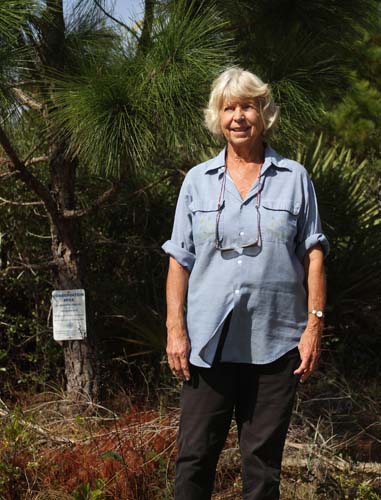SEBASTIAN — With only about 100 Florida Scrub Jays left in Indian River County outside a protected state preserve, Sebastian resident Jane Schnee wants to give the endangered birds a safe place to nest and forage for food this winter.
The pine trees on the 10.6-acre tract need to go, Schnee said. They’re useless to the Scrub Jays as food and they harbor predator hawks.
For the second year, Schnee has timed work days around the Christmas season to entice volunteers and local residents to not only come out and remove the trees, but to reuse them by taking one home.
Trudging out into the woods to chop down a tree for Christmas seems a tad more romantic and adventurous than picking one from a lot astride a big-box store, so Schnee invites everyone from Sebastian and its environs to come on down and get one.
The trees won’t be the majestic and perfect evergreens that would cost a bundle at the tree lot, but these native Florida pines are what she remembers from Christmases past.
“None of the trees really looks like Christmas trees, but as a kid, that’s what we had,” she said.
Raised in Jacksonville Beach, Schnee lived in Chicago and then the Florida Keys and in 2006 wound up in Sebastian where she took up birding as a hobby.
Three years ago, she began volunteering with the Indian River County conservation lands program doing scrub jay counts and helping county staff catch and band the birds.
Schnee heard that a parcel of land had been permitted to be developed into 80 two-story townhomes and instead of waiting for somebody to do something, she stepped up and did it herself.
“There’s been a 90 percent drop in the scrub jay population,” Schnee said. “Not including the St. Sebastian (Buffer Preserve) State Park, there are only about 100 scrub jays left in the county.”
Some days, Schnee says she wonders what she got herself into last year when she bought the 10.6 acres to help save Sebastian’s struggling scrub jay population, as she figures out how to pay the property taxes and to restore the habitat on her own without the government help she said she thought would be available.
But she’s smart enough to ask for help from the community when a task is overwhelming.
“Governments were, and are still out of money, so I bought the property myself and am relying on volunteer help to restore the habitat,” she said.
Her task this holiday season is to make way for the scrub jays to nest in February by chopping down as many of the slash pine and sand pine trees on the property as possible.
In an effort to lure volunteers to help, she’s asking them to come and haul away their very own “Charlie Brown Christmas tree.”
The leftover trees will not go to waste, as Schnee said the INEOS Bio company has offered to pick the trees up and convert them to energy at the plant near the Indian River County Landfill west of Vero.
The nature-lover in Schnee hates the thought of cutting down perfectly good trees, but she said the trees would normally be cleared by nature.
“It’s totally overgrown. In nature, the pine trees would be thinned out every seven to 10 years by wildfire,” she said. “Lightning would strike and it would start a fire, but now if a fire starts, we would put it out, so the property is totally overgrown.”
The Pelican Island Audubon Society has put the word out to its members to help chop and haul on the dozen work days – including this Friday, Saturday and Sunday – when Schnee she’ll be out on the property coordinating the work.
Unlike Brazilian pepper trees, the pines, if cut low enough to the ground, don’t grow back and the stumps don’t need to be treated with an herbicide.
So once the pines are cleared, the native scrub oak trees should have the space and the unfettered sunlight to be able to flourish on the property.
“Scrub jays need scrub oaks because a big part of their diet is the acorns from scrub oaks,” Schnee said.
To help things out, Schnee said she plans to purchase some scrub oak seedlings and plant them on a patch of land that the developer had clear cut.
Having the pines gone will also eliminate perching spots for hawks that lurk and swoop down to make a snack out of the smaller scrub jays.
The baby birds born on her preserve last year went missing. Schnee hopes they just left the nest early to find mates and new habitat, but she suspects they fell prey to the hawks.
Schnee said she has a permit from the City of Sebastian for the tree removal, but she does not have any tools, so volunteers should bring their own saws and work gloves, if they will need them.
“The small pine trees are pretty easy to cut through,” she said. “The larger trees are up to about 40 feet tall.”
Work days are scheduled for 8:30 a.m. to 1 p.m. on Nov. 30 as well as Dec. 1, 2, 7, 8, 9, 14, 15 and 16.
The property is located on Barber Street, about one-half mile west of U.S. 1 across from the Park Place mobile home community.
If a group wants to organize a work party on a different day, or for more information, call Jane Schnee at (772) 589-3201.

